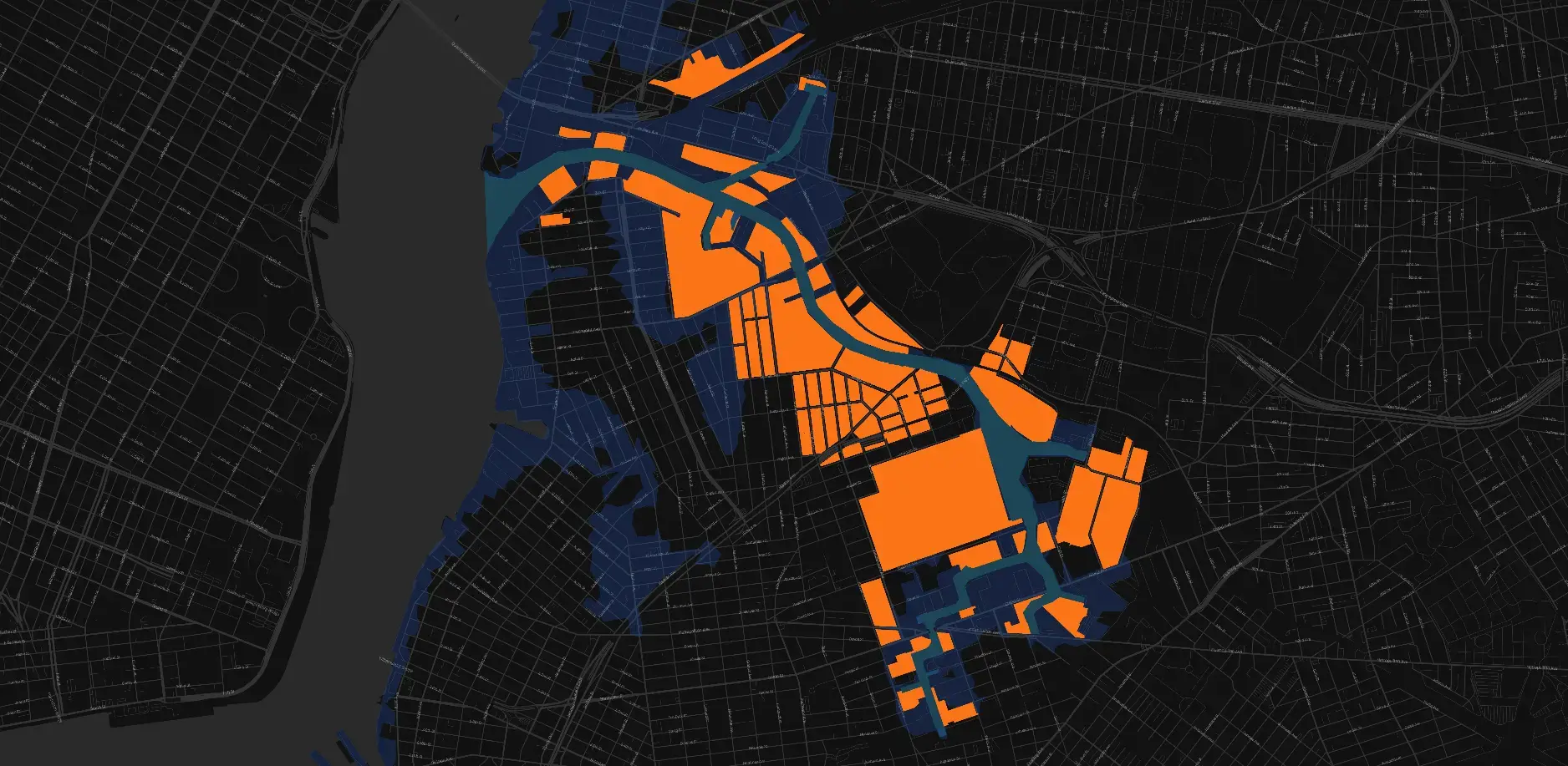
More than a decade after the EPA pledged to remedy Newtown Creek’s industrial contamination, the water is still dirty.
Hazard NYC was made possible by support from the Fund for Investigative Journalism. The project was produced in partnership with the McGraw Center for Business Journalism at the CUNY Graduate School of Journalism, and is part of the Pulitzer Center's Connected Coastlines initiative. Hazard NYC is sponsored by Brooklyn SolarWorks.

As a nonprofit journalism organization, we depend on your support to fund our nationwide Connected Coastlines climate reporting. Donate any amount today to become a Pulitzer Center Champion and receive exclusive benefits!

Once flowing through wetlands and marshes teeming with fish and birds, Newtown Creek became a major commercial hub about 200 years ago. Today, the creek is highly contaminated from decades of dumping and spills. It’s been more than 13 years since the Environmental Protection Agency took Newtown Creek into its purview, but the site still lacks a remediation plan.

In the 1800s, the creek was home to over 50 refineries that produced oil, petrochemicals, sugar, copper, chemicals, glue and other products. As New York City’s ports became shipping centers, the creek was dredged to make room for boats carrying goods.
By the early 20th century, the creek was bustling, with “commerce greater than that of the Mississippi River or any of its tributaries,” the New York Times wrote in 1912. But some businesses dumped chemicals into its waters.

Branching off from the East River, Newtown Creek snakes for almost four miles between western Queens and northern Brooklyn.

The EPA identified six entities as those mainly responsible for its contamination: Exxon Mobil, National Grid, Phelps Dodge Refining Corporation, BP and Texaco, plus the City of New York itself.

Because the city’s sewers handle both stormwater and wastewater, raw sewage spills into the creek when it rains.

The creek’s sediments are contaminated with metals, including lead and copper, chemical compounds, including polycyclic aromatic hydrocarbons (PAH) and polychlorinated biphenyls (PCB), and dioxins.
Long-term exposure to these contaminants could cause cancer, organ damage, rashes and cataracts. The biggest pathway for exposure is eating the fish and crabs from the creek.

LaLaura Hofmann, a lifelong Greenpoint resident, grew up near the creek and played on its banks.
“There were those days that you got up, and the smell was so bad that it could make you want to vomit,” said Hofmann, who became one of the most vocal proponents of its clean-up.

The EPA designated Newtown Creek a Superfund site in 2010. As part of the Superfund program, the feds oversee the remediation of the creek, with the entities that polluted the place on the hook to pay for it. The EPA identified 14 other parties in addition to the five main companies and the city, and continues to look for more.
In the meantime, flooding could spread the creek’s contamination — and make its water more polluted.

Neighborhoods surrounding Newtown Creek are in a 100-year floodplain. That means there is a 1% chance of a major flood happening in any given year. As a result of climate change, sea levels are predicted to rise between 6 inches and just over a foot by the 2030s, according to estimates by the New York City Panel on Climate Change.

Tidal flooding or rising groundwater could cause chemicals in the land next to the creek to seep into its waters. The state Department of Environmental Conservation is looking into some nearby properties to see if those also need remediation.

Hurricane Sandy in 2012 flooded many of the businesses on the creek’s banks, including David Flatt’s furniture workshop in Long Island City. The space got at least three feet of water, he said, ruining some of his work. “The water is toxic, and all that water flowed in,” Flatt said. “At some point, this building will need some better defenses.”
The EPA sampled some floodwaters after the storm, finding elevated levels of bacteria from sewage. Sandy also caused fuels and oils from outside the creek to leak into the waterbody.

Another effect of climate change is more frequent and more intense rainfall — which means more sewage spills.
New York City is planning to build a massive underground tunnel that will hold wastewater during rains once the sewers reach capacity. When the storm ends, what’s captured will go to the treatment plant instead of flowing into the creek. But that won’t be finished until 2040.

In the meantime, locals are looking to the future.
“We're really interested in how the creek can be an example of an industrial space that also has significant ecological function and community access and benefit, ” said Willis Elkins, executive director of the Newtown Creek Alliance. “The people that are working here every day — they should deserve to be able to work in a place that doesn't have legacy contamination.”

All kinds of businesses still operate along the creek’s banks, including food and beverage distributors, concrete suppliers, recycling centers, auto shops and a fuel storage facility.
“Newtown Creek separates two industrial areas, ” said Charles Yu, vice president of economic development at the Long Island City Partnership. “It's an active commercial waterway that some of these businesses rely on.”

In spite of its pollution, runners and birders frequent the creek’s banks. Schoolchildren spot tiny fish swimming. And boaters take to the water.
“They’re frontiersmen, ” Hofmann said. “They're forcing the agencies to look at the quality and the standards for the creek just for the simple fact that they're there and using the creek in that way.”

Sarah Durand, a biology professor at LaGuardia Community College, installed more than two dozen basins with marsh grasses along the bank of the creek. These provide natural habitats for organisms like mussels and crabs.
“Our little river, devastated by our commercial culture, gives such pleasure even in its current condition,” she said. “There's so much potential here for communities land-side and communities water-side to heal together.”
Credits:
Written and reported by Samantha Maldonado. Design and development by Sam Rabiyah. Editing by Harry Siegel. Photos by Ben Fractenberg, Alex Krales, Marcus Santos, and Samantha Maldonado. Additional development by Sujin Shin. Archival Newtown Creek via NYPL Digital Archive. Additional reporting by Jordan Gass-Pooré.
Data sources: Superfund site boundaries and potentially responsible parties via the EPA. Sewer overflow locations and remediation sites via the DEC. Floodplain data via FEMA.














